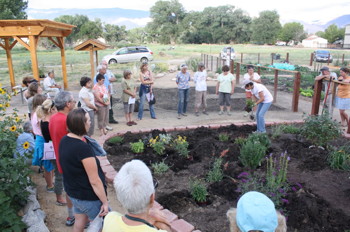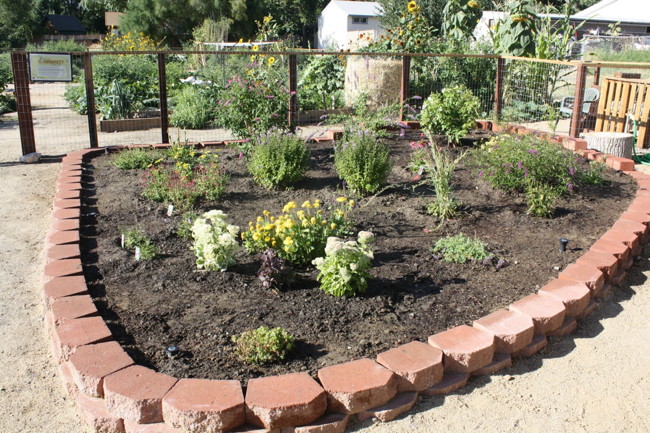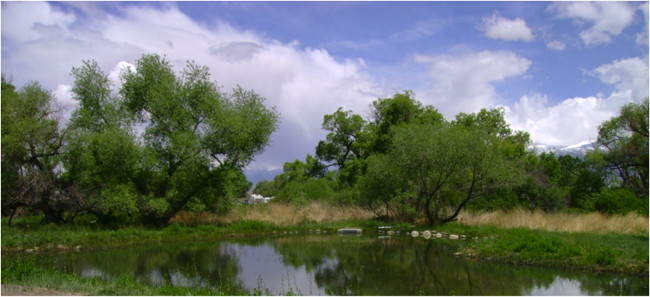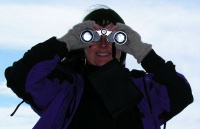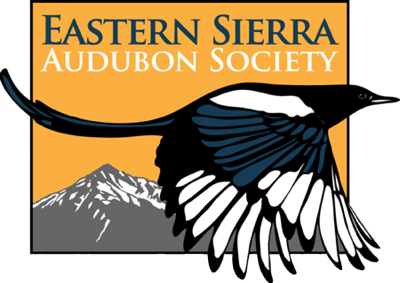
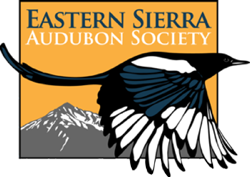
Sierra Wave
Newsletter
Volume 32, Number 5
May-June, 2014
Sierra Wave Newsletter
Volume 31, Number 4
March-April, 2013
Contents
- Events:
- Features:
- Reports:
- Business
Events
CANCELLED JULY Program: Birds of Brazil: Brazilian state of Mato Grosso
Unfortunately, we've had to cancel this program as we've had a hard time making it work for this summer - we hope to have Matthew back again someday when he is available. Our next program will be in September - check back for details.
Specific Date and Venue TBA - check back!
Brazil conjures up many images among Americans—Rio de Janeiro, the Amazon, tropical rainforests and abundant, exotic animals—especially its stunningly colorful birds.
The largest country in South America, Brazil is home to a hugely rich diversity of avifauna—more than 1,800 species of birds, more than 200 of them endemic (found only there). Sixty percent of the birds native to South America occur in Brazil.
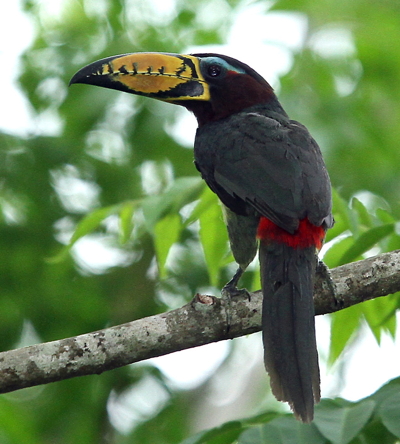
Lettered Aracari, Chapada, Brazil - Photo by Matthew Matthiessen
Matthew Matthiessen visited the Brazilian state of Mato Grosso in October 2011, birding from the Amazonian rainforest in the north to the extensive wetlands of the Pantanal in the south. This area harbors some of the most sought-after, beautiful birds in the world, including the Harpy Eagle, the Hyacinth Macaw and the Agami Heron.
In July (Date and Venue TBA), Matthiessen will share some of his Brazilian fun-and-adventure experiences in a slide presentation, “Birds and Birding in Brazil.” His talk features many of his superb photographs, not only of Brazil's eye-popping birds, but also some of the region's non-avian wildlife, including its impressive mammals.
Matthiessen began birding while growing up in Thailand, developing a lifelong love for international birding. An extraordinary birder and bird photographer, he has pursued his birding passion in many countries throughout the world and captured hundreds of images through his camera lens.
His adventures have also produced some memorable, heart-pounding experiences. He has lived through two bloody coups—one, in Thailand, successful, and the other, in Zambia, not. He has been charged by an elephant, stalked by a lion and threatened by a crocodile. He has kissed a cobra, push-started a Jeep amidst a lion pride, had the spotlight die while next to a leopard, captured a 14-foot python and almost tripped over a sleeping silverback gorilla. Matthiessen will no doubt share some of his unusual experiences in his presentation.
Please check back to our programs page and watch for our monthly email update to get the date and venue for this sure to be fascinating program!
For more information contact Jenny Richardson (email jennyn63@gmail.com or call 760-920-8541. Also, check back for updates to the list of future speakers. Everyone is welcome to attend all programs!
Back to Top
Upcoming ESAS Field Trips and Other Events
May 10th and June 14th: Monthly Bishop Paiute Tribe COSA Bird Walk and Census
[Ed. Note: COSA walks are held on the second Saturday of every month, unless otherwise indicated]
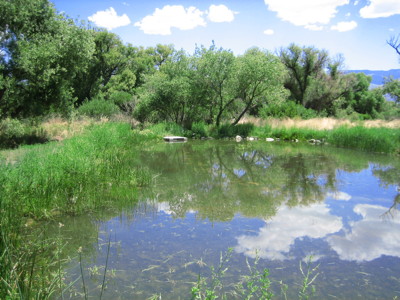
Pond at the COSA - photo by Brian Adkins
Our Conservation Open Space Area (COSA) Bird Walks and Censuses will be held on the second Saturday of May (5/10) at 8:30am, and the second Saturday of June (7/14) at 7:30am. Unless otherwise indicated, our COSA bird walks will all be the second Saturday of the month, except for December, because we will have it coincide with the Christmas Bird Count. During June, July, August, and September they will start at 7:30 instead of 8:30. Watch the monthly email update, the field trips page on our website, or local media for confirmation, updates on leader(s) and meeting time. Or, contact Hillary (below).
The Conservation Open Space Area is being developed for wildlife and the community by the Bishop Paiute Tribe. We are keeping species lists and observing behavior as well as identifying birds, for the purpose of creating bird lists for the site. For more information, read this article on the COSA in the March-April 2013 Sierra Wave newsletter. There have been surprises every month so far - come find out what new birds we'll see next time!
All are welcome - these walks are for birders of ALL LEVELS, beginners included! We will bring extra binoculars and field guides to share.
Please meet at 8:30am at the BLM/Forest Service Building on West Line Street in Bishop. Contact Hillary Behr for more information, or if you are interested in leading a future monthly walk: Hillary.behr@bishoppaiute.org or call (760) 920- 5287.
Back to Top
May 10th, Saturday: Birding & Stewardship at Convict Lake (Friends of the Inyo)
[Not an Audubon walk, but something our members may be interested in!]
Celebrate International Migratory Bird Day with Friends of the Inyo at Convict Lake. Help us kick off the season with a walk to discover birds around the lake and a volunteer project to help clean up the area as the busy fishing season begins. Bird walk begins at 8am; Clean up project starts at 10am. More information is available at friendsoftheinyo.org or by calling 760-873-6500.
Back to Top
May 17, Saturday: Mammoth Creek Birding; Leader, Ken Wells
Discover Warblers, Woodpeckers, and Hawks
with avid birdwatcher Ken Wells.
Walk along Mammoth Creek spotting springtime birds
and hearing their songs.
Meet at Mammoth Creek Park 8am.
Walk to Mammoth Museum, approximately 2 miles round trip from 8-11am.
Binoculars will be helpful.
For more info call Ken Wells 760-924-0013
Back to Top
Willow Flycatcher and Yellow-billed Cuckoo Spring and Summer Surveys
Local birders should be aware of an ongoing project on these two species (SW Willow Flycatcher and Yellow-billed Cuckoo) through July 31. If you have any observations please submit the data to Lacey Green (see below).
CDFW in coordination with LADWP and PBCS (formerly PRBO: Chris McCreedy) will be doing an Owens Basin Willow Flycatcher survey this spring through summer (May 15th- July 31). It would be most appreciated if you share any observations you have of identified or unidentified empids this spring and summer so we can follow up to find out if they are nesting at the locations or just passing through. Our target area is the entire Owens Basin below 6,000 feet, with a real focus on LADWP lands to help guide their habitat conservation plan.
If you have any observations please submit the data to Lacey at Lacey.Greene@wildlife.ca.gov.
Back to Top
MONO LAKE NEEDS YOU!
Volunteer Program at Mono Lake this summer
The Mono Lake Committee, US Forest Service, Eastern Sierra Interpretive Association, California State Parks and the Bodie Foundation are teaming up to sponsor the 11th season of our volunteer program at Mono Lake this summer. Volunteers will have the opportunity to meet people from all over the world and share their knowledge of the Eastern Sierra. Participants may staff information desks and/or rove and answer questions at the lakeshore. Free training will be held on May 28 & 29 and June 4, 5, 11 and 12th in the Mono Basin (Wednesday and Thursday afternoons) .
Please contact Rose at rose@monolake.org or 760-647-6595 for more information or to sign up. You will be sent details and a training schedule.
Back to Top
The Mono Basin Bird Chautauqua is June 20–22, 2014! The Chautauqua features birding field trips and programs all day Friday and Saturday and Sunday morning with a picnic in the park on Sunday afternoon, featuring year's musical guest Jelly Bread. Go to birdchautauqua.org for updates!
Back to Top
September 13, Saturday: Owens Lake Bird Festival, Friends of the Inyo
This is not an official Eastern Sierra Audubon event, but many of us will be participating! Friends of the Inyo is organizing the first ever Owens Lake Bird Festival Sept. 13th. They are looking for partners, planners, trip leaders, program givers, photographers, artists. Field trips will focus on Owens Lake with extra trips along the Lower Owens River and up to Horseshoe Meadows. Contact Mike Prather at mprather@lonepinetv.com.
Back to Top
Back to Top
Features
President’s Message
“The true place is not on the map.”
— Herman Melville
There is nothing that prepares me for spring, including all of the previous springs I have experienced. Incremental shifting is difficult to notice in real time. Without conscious effort, the conditions of winter—the amount of daylight, the quality of light, the bare limbs of the trees—become the norm even as they begin to give way to another season. Little bits of change—a difference in the wind, a glimpse of green at the base of what looks like a dead plant, a familiar bird song—are important signals, but they do not quite register as what they are. My journal for March second tells me I saw "the promise of spring lurking,” and by April third I had concluded that “spring is now relentless." Now, I am having difficulty remembering the details of winter, and there is no way that I can see forward into the heat and landscape of summer. It is just eternally spring.
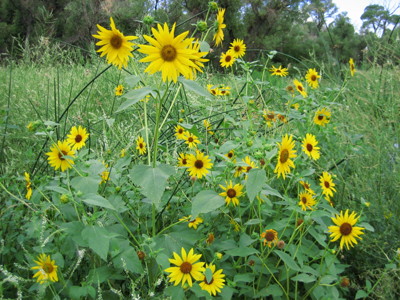
Sunflowers in the COSA
I am not sure that I see this as a season of hope as it is advertised. That is pretty hard to do in a year in which the snow pack cites below 20% of what we call the norm, as though anything was "normal." The summer looms as something which we are going to have to push through with as little damage as possible. What spring is, though, is a massive flexing of the muscles of the natural world. These processes that bring forth the grasses, budding and sprouting of leaves, and bright swaths of flower color on the hillsides are simply undeniable. Every day coaxes more life into my backyard. The pull of spring brings me birds I had forgotten would be here. A look at our first sighting records shows me that the window for the appearance of these travelers is pretty tight regardless of the type of weather of the winter. What is subject to change are the conditions that they find when they arrive.
This past weekend, the State of California has again allowed me to visit the world of trout. I have reacquired an officially sanctioned excuse to wander along streams watching and learning. So many birds were there to meet me, singing and making woodpecker noises; squabbling and hurrying about carrying nesting materials, occasionally flashing bright colors across my eyes. I am grateful that I am here again for this. This surge of life is so strong that it sweeps me with it. I cannot focus on specific plans and lists of things to do, I simply know that it is time to get moving and exploring and looking for connections to this landscape.
It is a blessing to be in this place with the people of Eastern Sierra Audubon. There are few experiences as enriching as walking quietly within a group of people whose collective attention is directed to a subtle bit of movement in a dense cluster of leaves. I treasure the shared experiences of Lazuli Buntings, eagles and hawks and the brilliance of tanagers, grosbeaks and orioles. I am honored to be a part of an organization which strives to make the road to college a bit easier for Eastern Sierra students, to bring groups of excited grade schoolers into contact with the Bishop Paiute COSA area and brings the focused image of a bright yellow goldfinch to their wondering eyes.
Thank you for the opportunity to do this good work with you all. May spring sweep us all to new heights.
Pete Pumphrey
Back to Top
Eastern Sierra Audubon Is Now A Tax-exempt Non-Profit
There has been a significant change in status at Eastern Sierra Audubon. The chapter has incorporated as an official non-profit and has been awarded tax exempt status under IRS section 501(c)(3). The most significant effect of this change centers on contributions and donations to the chapter. These are now tax exempt. This affords a benefit to those who so generously support ESAS whether through the annual bird-a-thon, legacy donations or other gifts. It also enables the chapter to seek funding from other non-profit, foundation or governmental sources. We had previously secured funding to support PRBO Science in its gull research at Mono Lake. Getting that done was complicated by the fact that, at that time, we did not have 501(c)(3) status. There are many research efforts that go on here in our part of the world and the chapter sees a lot of value in being able to help secure the funding necessary to keep them going forward. In addition, we would like look into developing interpretive information and projects in locations like the Bishop Paiute COSA, Bishop City Park, Owens Lake and other locations. Our new status will help us in those endeavors.
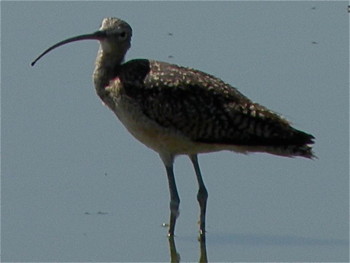
Whimbrel on Owens Lake, Photo by Michael Prather
This change does not have a lot of direct impact on ESAS members. The biggest change concerns the election of the board of directors and officers. In the past members voted to elect these persons. However, there was a continual problem obtaining enough of a turn-out at the June meeting to constitute a quorum under the former rules of operation. This was not as significant an issue when the chapter was simply an association, but would be problematic in a corporate situation. The corporate bylaws provide that members of the board will be elected by the board as will officers. Following the initial incorporation, the existing board members were named to the board by the incorporators to insure continuity in the transition. This does not mean that members have no role in determining the composition of the board or who serves as an officer. What it does mean is that persons who wish to suggest the name of a potential board members or volunteer for service need to contact a board member with that information.
Our new status does not mean a change in the character of the operations of the chapter. The chapter does need money to operate. Binoculars break and we need more so we can work with more schools throughout the two counties we serve (ESAS is the only multi-county chapter in California). We need to continue to support deserving graduating high school seniors through the Eastern Sierra Audubon scholarships. We continue to work with the Bishop Paiute Tribe to develop outdoor education opportunities at the COSA area. We do want to develop continue and distribute interpretative materials to help promote the mission of Audubon (our Birding Trails Map was named one of the forty best birding trails guides in the United States by National Audubon). We look forward to finding new and creative ways to work with our community in support of birds and their habitat.
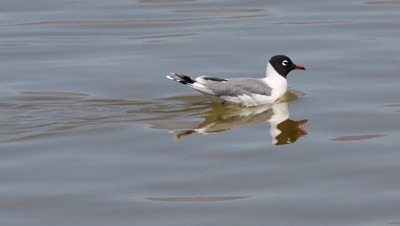
Franklin's Gull on Owens Lake, Photo by Chris Howard
We are sustained in all this through chapter memberships and the kind donations of members as well as the proceeds from events such as the yard sale and bird-a-thon. We will seek special funding for special projects and our new status gives us greater flexibility and eligibility for grant support in these endeavors. However we will not be sending out monthly solicitations for funds or anything of that nature. ESAS has learned to function and function well on a small annual budget. We are able to do this because of the amazing willingness of members to volunteer to do the many things that keep things running. That has not changed. We have a continual need for persons to come forth with their particular ideas and passions within the Audubon mission.
If you would like to be a part of our positive contributions here in the Eastern Sierra, contact any board member and we will help find a way for you to do so!
Pete Pumphrey
Back to Top
Winter 2013-14 Highlights for Inyo County
[Birds in bold type have a photo in the article (or linked) - click on any photo to see all in a slideshow]
By Tom & Jo Heindel
Neotropical migrants are arriving daily and filling birders with excitement. Spring migration, many would argue, is the most anticipated bird event of the year. In part, this may be because it follows what is usually the least exciting season–winter–since so many species depart the eastern Sierra where insect and fruit supplies become scarce and the weather can be less than hospitable.
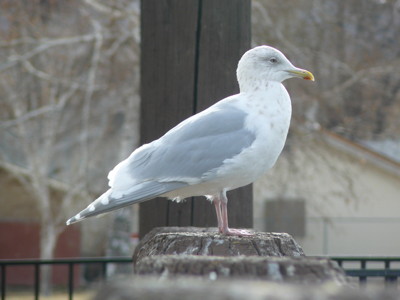
Kumlien's Iceland Gull, photo by Chris Howard
That said, this winter was not unexciting! The Winter 2013-14 Inyo County Seasonal Report to North American Birds included almost 50 species that were significant records for the county submitted by almost 30 observers. What follows are the highlights of those highlights starting with the most exciting find of the winter, a Kumlien's Iceland Gull found by Chris Howard at the Bishop City Park 23 January. Happy New Year!! The bird remained through 29 January and was seen by most local birders with some birders coming from southern CA to enjoy the event. Chris followed the protocol to a "T" and called birders immediately and got the word out.
He soon was surrounded by a small crowd with many clicking their cameras recording the gull in every position it took. Models treading the walkway are not blitzed with more flashes than this gull! This species is so rare in the state that the sighting needs to be evaluated by the California Bird Records Committee to determine if it meets this committee's criteria to be accepted as a state record. One committee member, on seeing all the images and documentation that our local group submitted, commented that this is likely the best documented Iceland Gull in the state! This would be the first Inyo County record if accepted by the CBRC but there is one heck-of-a-mountain to surmount. There are dozens of images showing every mark one would want to view to determine what this bird "really" looked like. The various cameras, settings, lighting, positions, etc. provide almost as complete a picture as a specimen…but not quite. In this case, even DNA might not give us an unequivocal answer. With our lack of understanding of the range of variation of Kumlien's Iceland and Thayer's Gulls, this bird may have to wait a long time before being given an official name. But for the group who absorbed this experience, the bird transcends its banal name whatever it is, since it was a species that has never occurred here before.
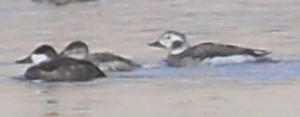
Long-tailed Duck at Owens Lake
Photo by Debbie House
A number of other species were of special note because of their overall rarity or rarity during the winter season. A female Long-tailed Duck, casual in the county, was photographed at Owens Lake 27 January (DJH). A casual species is recorded fewer than seven years per decade. An adult female and an immature female Barrow's Goldeneye were found at Pleasant Valley Reservoir 13 December (CBH). This casual pair was refound at the Bishop Sewage Ponds (Waste Water Treatment Plant) the following day (T&JH) where they remained until 16 December. A rare adult Pacific Loon, in basic plumage, was at Klondike Lake 10 December and an hour later, the same or another bird in similar plumage was at Tinemaha Reservoir (TSH).

Sandhill Crane, Furnace Creek Ranch
Photo by Ryan Gallagher
A casually occurring White-tailed Kite was found just south of Big Pine 15 February (C&RH, SLS) and a casual Sandhill Crane was photographed on the edge of the airport at Furnace Creek Ranch, DVNP, 4 December (RCG). One Greater Yellowlegs was recorded at Bishop 6 January (J&DP) when it is casual away from Owens Lake. It was found a day earlier but the original finder submitted no documentation. A Nuttall's X Downy Woodpecker hybrid female was found in the Independence tree lot 11 February (JTZ) and likely is the same bird reported there 28 October 2013 (KHL). This hybrid pairing is casual.
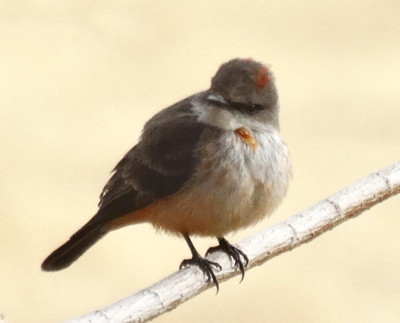
Vermilion Flycatcher, Independence, photo by Nancy Overholtz
An immature male Vermilion Flycatcher, rare in the Eastern Sierra, was recorded at Independence 22 January (JTZ) and photographed 26 January (NJO). A female Vermilion, photographed at Furnace Creek Ranch 5 January (C&RH) continued there through 27 February at least (T&JH). A rare Pacific Wren was found in Aspendell 26 November (WHM), refound there 20 December (B&SS, NJO), and again 2 January (WHM). Blue-gray Gnatcatcher is a casual species in winter so the two reports were real surprises. One bird was found three miles southwest of Bishop at 6055ft 6 January (WHM) and an amazing group of three birds (one male & two females) was in Redding Canyon, White Mountains 14 February (R&NO).

Curve-billed Thrasher, Starlite, photo by Penny Kehus
The truly amazing Curve-billed Thrasher continued at Starlite throughout the winter period (R&KS, PK, SLS) and is developing quite a resume of images thanks to the watchful eyes and always ready cameras of the residents there. It has accrued 21 months of residency as of this writing. One Black-throated Sparrow, casual in winter, was recorded in Silver Canyon, White Mountains 14 February (SLS) and a rare Swamp Sparrow was found at Furnace Creek Ranch 5 January (C&RH). A rare 'Pink-sided' Dark-eyed Junco was reported twice this past winter. One bird was at Round Valley 14 December (JLD) and another was in Big Pine 25 February (T&JH). Although this species is rare, it is recorded annually in very small numbers.
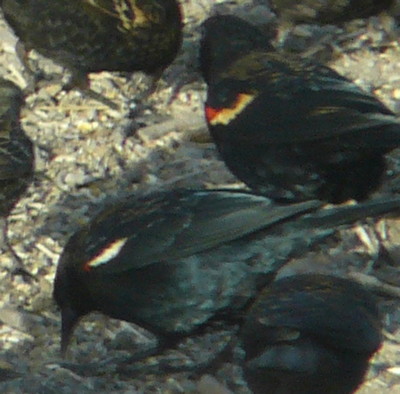
Tricolored Blackbird, Bishop, photo by Chris Howard
Totally unexpected were two Tricolored Blackbirds, not only a casual species but not recorded in the Eastern Sierra in winter. They were photographed in northwest Bishop for a week beginning 11 January with the adult lingering through 13 February (CBH, et al.). And lastly, the first winter record ever of a Hooded Oriole began at Furnace Creek Ranch 18 November (ANMcG, BPK, HSP) and was reported almost weekly through 28 February (T&JH). It bears reminding that no species are reported to North American Birds or discussed in the WAVE unless the species is well documented and/or photographed.
Kudos to the following bird data gatherers who are leaving more than wind-blown rumors of what they saw: [initials alphabetized by first name], ANMcG-A. Naomi McGraw, BPK-Bob Kiernan, B&SS-Bob & Susan (SLS) Steele, C&RH - Chris (CBH) & Rosie Howard, DJH-Debbie House, HSP- Scott Page, J&DP-Jim and Debby Parker, JLD-Jon Dunn, JTZ-Jerry Zatorski, KHL-Kelli Heindel-Levinson, PK-Penny Kehus, RCG-Ryan Gallagher, R&KS-Rick and Karen Scott, R&NO-Ron & Nancy (NJO) Overholtz, T&JH-Tom (TSH) & Jo Heindel, and WHM-Bill Mitchel.
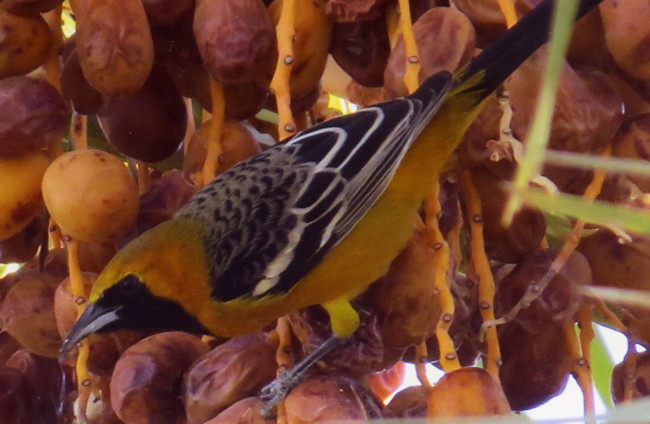
Hooded Oriole, Furnace Creek Ranch, photo by Bob Kiernan
We solicit your help in making each seasonal report more complete so consider submitting reports of interesting and unusual sightings of rare or very rare species, along with documentation and/or images to tjheindel@gmail.com. Information on which birds need extra documentation, and how and when to submit, is on our Inyo Bird Checklist page.
Tom and Jo Heindel have contributed a vast amount of their knowledge to the Wave Newsletter over the years (from 1993 on!). Those articles have been archived for reference, here: Heindel's articles and season highlights.
Back to Top
Poetry
May's End
Filling feeders day by day
Noisy leaves above, goldfinches
Not so patient
Well it’s Black-chinned season too
So sugar water finds toes
When hands reach up to hook the fresh batch
Back to the tubs for sunflower seed
As, after all, House Finches are nesting
And who can resist a mom
Not I
Feeder filling
Time it takes
Suddenly
The zip of siskins
Psychedelic flamed crest of Cassin’s Finch
And Costa’s gorget flare
Routine transformed into dance!
by Barbara Kelley
Back to Top
Audubon Bird and Butterfly Garden
Eastern Sierra Audubon is sponsoring a pollinator paradise in one of the demonstration plots in the Bishop Community Garden. In May of 2013, ESAS members Kathy Duvall, Rosie Howard, Serena Johnson, and Bill Mitchel worked with the Master Gardeners of Inyo and Mono Counties to ready the plot for planting. Many hands made light the tasks of removing grass and weeds, filling the plot with good soil, and leveling pathways and covering them with weedcloth and decomposed granite. After conducting research, plants were purchased locally with a generous donation from ESAS. The Parkers and Howards donated plants that hummingbirds love from their home gardens. Indeed, the pink penstemon from the Parker's garden is the preferred plant by Rufous and Black-chinned Hummingbirds. Spend a few minutes sitting at the picnic tables in the shade of the new pergola and watch the territorial battles wage!

On June 24, 2013, eight Master Gardeners and two ESAS members held an educational workshop at the outdoor classroom in the garden. Thirty-five interested folks from the community attended and learned the needs of resident and migrant birds, pollinators, and plants. After a half hour of instruction, and many questions and answers, the real fun began. Wielding their trusty shovels, the Master Gardeners demonstrated best practices for planting. In the next half hour, twenty-six plants were in the ground! Because the Native Plant Society is sponsoring a native plant area next to Audubon's, we chose non-invasive, nutrient rich plants to provide a variety of food sources in the demonstration area.
Plant lists from the workshop are available here for download.
Here are some recommendations paraphrased from the UC Davis Arboretum Terrace website:
Home gardeners can create a refuge for birds and insects making our homes their home too. It’s hard for animals to make a living when their food sources and shelter disappear. Choosing plants that animals use for food and shelter and providing a water source in the garden helps them thrive. If we make our gardens good homes for the inhabitants of the natural world, in return insects and birds will pollinate our plants and bring our gardens to life with sound and motion.
Make your garden a feast. Your garden can be a “pollinator’s buffet” where bees, hummingbirds, and butterflies can cruise your flower beds and sample the tasty pollen and nectar from your garden plants.
BUTTERFLIES are active during the day, can see some color but have a poor sense of smell. They prefer brightly colored daytime bloomers with landing platforms where they can rest while drinking nectar through their long mouth parts.
BEES see all the colors we do, except red, and so are likely to pollinate yellow and blue flowers. Bee-pollinated flowers like sage or lavender often smell good to people.
HUMMINGBIRDS fly during the day, have keen sight but a poor sense of smell. Hummingbird flowers are often red or orange, are tubular in shape to fit long, slender beaks, and produce copious amounts of nectar.
The Audubon Bird Butterfly garden is located in the Bishop Community Garden behind the Bishop City Park south of the Senior Center. It's a great place to have lunch in the shade. Current lunch entertainment includes Orange-crowned Warblers, Lesser Goldfinches, Rufous and Black-chinned Hummingbirds, House Finches, House Wrens, Audubon's Warblers, butterflies, and occasional Black Phoebes and Spotted Towhees. Come visit at different times of the year to enjoy resident birds as well as fall and spring migrants as they pass through the flowers blooming at different times in the Audubon Bird and Butterfly Garden. Hope to see you out there.
Rosie Howard
Back to Top
First-Time Species at Eastern Sierra Wildlife Care
[NOTE: this article was originally sent for the September-October 2013 newsletter, which never went to "print"]
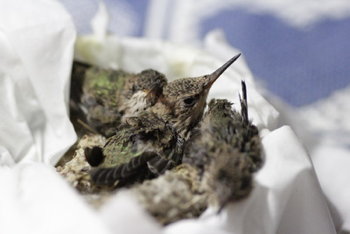
These three baby hummingbirds were apparently blown out of the same nest by a leaf blower!
One of the benefits of working in wildlife rehabilitation is the opportunity to see our native wildlife—birds, mammals and reptiles—up close and personal. They come to us for a variety of reasons, some natural, most human-related. Adults are hit by cars, caught by cats or dogs, tangled in fishing line, poisoned and shot, electrocuted, emaciated. Babies often arrive uninjured; nests blow, fall or are cut down, the mother is found dead or disappears, a nestling falls or is bumped out.
Most babies are charming and cute, whether mammal, avian or human. Rehabbers quickly fall under the spell of two tiny pin-feathered hummingbirds snugged in their soft nest. A hummingbird-sized catheter, attached to a 1 cc syringe filled with special hummer formula (no sugar water!), must be aimed carefully into the small orange-lined mouths. Twenty minutes later, we feed them again and again throughout the long summer day from dawn until dusk. Who can resist the soft-furred dumpling of a baby cottontail with his dark watchful eyes? He must be handled slowly and gently because he might startle and die—his heart stopping—a mechanism of mercy for these creatures who are prey to almost every predator, furred, feathered and two-legged.
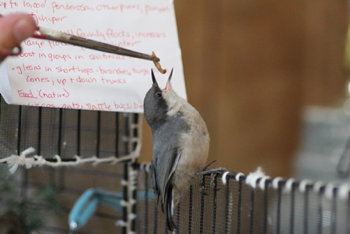
Pygmy Nuthatch getting fed a mealworm
This season brought two never-before seen babies to Eastern Sierra Wildlife Care: a Pygmy Nuthatch and a Mink. The tiny nestling Nuthatch was found at Shady Rest Campground in Mammoth; some kids were playing catch with her! The 3-week-old Mink, eyes closed, was found on an empty boat docked at Crowley Lake Marina.
Pygmy Nuthatches are one of the few songbirds in North America that have nest helpers; our little one had a lot of human helpers. They live and nest in large extended family groups. In cold weather, they nest in cavities, piling lots of nuthatches in the same hole (one researcher counted 100!).This bundle of downy feathers kept up an almost constant sweet repertoire of tweets, twitters and cheeps, gaped readily, and grew rapidly. She has been eating completely on her own—mealworms and waxworms mostly—and just moved into a larger cage where she can condition for release.

Baby Mink nursing - eyes are still closed!
In the late spring a “ferret” was trapped at Bishop City Park and brought to us. Only after some research did we determine that this graceful and ferocious chocolate-brown creature was a Mink. When the “baby weasel” arrived from Crowley, we recognized it immediately as a baby Mink. (Mink are native to most of North America. They belong to the Mustelid family along with badgers, wolverine, fisher, pine marten, river otters, skunks, black-footed ferrets, and weasels.)
Unlike the Nuthatch, the baby Mink had a single foster “mom” to prevent habituation. He was an eager eater and, as he neared 5 weeks in age, became very active; his eyes opened a few days later. In the wild, Mink are semi-aquatic and hunt in the water and on land. Prey consists of fish, crayfish, aquatic and land insects, lizards, cottontails, birds and eggs, and more. He has just moved into a large pen with a large pool and willow, tules, and tree roots and branches to climb and hide in. Everyone is enamored of this graceful and playful animal but we get only a few glimpses through peepholes in order to keep him wild.
What a treat it is for all of us to become so intimately acquainted with these two beings. They are very different from one another but both are elusive. The Nuthatch is often heard high in the pines but not so easily seen. The mostly-nocturnal Mink is fairly common near waterways, lakes and ponds, but rarely spotted. Having served as parents and helpers, we find ourselves tuned in to their presence in a new and special way.
Cindy Kamler
Editor's Note: Learn more about Eastern Sierra Wildlife Care and how to help or donate on their website: eswildlifecare.org
Back to Top
Conservation Alert: Pipes Are Bird Death Traps!
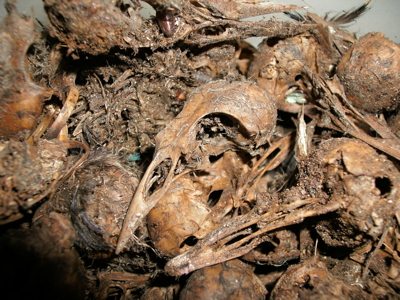
Bird remains - these birds died from being trapped in open-topped pipes
For decades now, birds of 45 different species have been attracted to open pipes like mining claim markers, building vents or corral fencing. Whether the pipes were made of plastic or metal and ranging in diameter from as little as 1.5 inches to 10 inches, these unfortunate birds have died as a result. At Audubon’s Kern River Preserve a 6-inch diameter irrigation vent pipe that had been in place 50 years contained 231 bird skulls. Ash-throated Flycatchers, bluebirds, flickers, wrens and more are all at risk from simply looking for food or a nesting opportunity.
What can we do?
- When you find mining claim markers that are not capped, pull them up – they are illegal.
- Open pipes in fences and corrals can be filled with gravel, sand, cement or fixed with a welded cap.
- Vent caps are available for vents on buildings and motor homes.
- Spread the word to people that you know
- Report pipes to Eastern Sierra Audubon and we will investigate solutions.
For more information and more of what you can do to help, see this flyer from Kern Audubon: death_pipes.pdf
And this on their website: Death Pipes - Open Pipes Kill Wildlife
From American Bird Conservancy: Mining Claim Markers Cause Millions of Bird Deaths in Nevada
And, Nevada Citizens Asked to Help Prevent Deaths of Thousands, Maybe Millions of Birds
Michael Prather
Back to Top
Reports
Bishop Paiute Tribe Conservation Open Space Area (COSA)
Updates from Last Summer
With the seasons, the COSA has changed dramatically from bare winter trees and brown grass to a jungle of spring green buzzing with insects and activity, and will soon settle into its late summer look of sunflowers, grasses heavy with seeds, and goldfinches.
A lot has gone on this summer on the Tribe’s 25 acre conservation area. Eastern Sierra Audubon has continued the monthly Bird Walk and Census on the second Saturday of every month. People brand new to the Chapter have showed up and the place has been packed with amazing birds. Some highlights were the Blue Grosbeak, Lazuli Bunting, Greater Yellowlegs, and an Osprey with a fish! For a partial list of birds seen on the COSA this season so far, click here.
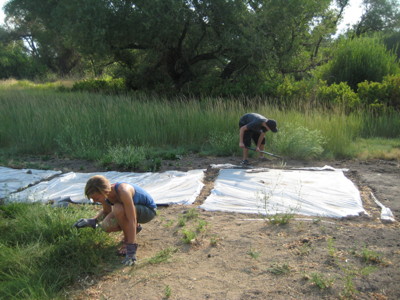
For the Tribe’s Environmental Management Office, restoring native vegetation and discouraging invasive plant species on the COSA has been a project that will continue well into the future. One exciting strategy has been solarizing the soil around the Pupfish Pond. This area was infested with an invasive species called perennial pepperweed at the beginning of last summer. The IMACA Youth Conservation Corps crew spent three days on the COSA putting down clear plastic that will cook the ground and kill weeds and seeds. The crew also collected native creeping wild rye seeds, pulled invasive sweetclover and bull thistle, and helped keep pond weeds under control. In the fall, the plastic was removed and the area was planted with native wildflowers and grasses.
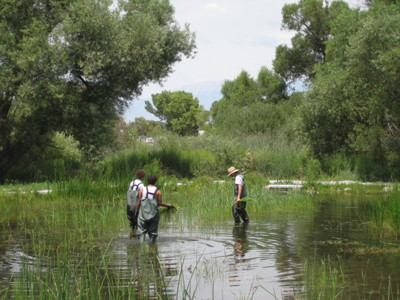
Volunteers from the Bishop Paiute Tribe, US Forest Service, BLM, US Fish & Wildlife, CA Fish & Wildlife, Sierra Nevada Conservancy, Eastern Sierra Land Trust, and the general public came out to help pull weeds, collect native seeds, clear brush, and maintain the solarization plastic during COSA Stewardship Days. These open volunteer days were held every other Friday morning through the summer and fall. It is very exciting to see many members of the community take an interest in this beautiful area. For more information and to volunteer, contact Hillary Behr at (760) 873- 3584.
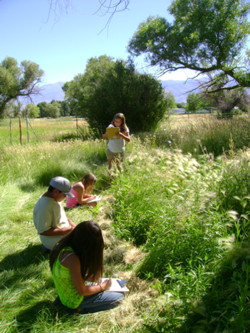
If you were walking on the paths this spring and last summer, you might have seen kids hiding in the bushes, looking at animal tracks, journaling, or learning to use binoculars. The Tribe’s Environmental Management Office (EMO) helped with Birds in the Classroom this spring and students practiced birding right outside their school’s back door. The EMO also invited students from the Tribal Ed Center to visit the COSA throughout three weeks of their summer program. The COSA is a fabulous place for environmental education and for people of all ages to connect to nature. As the EMO continues to work with the Tribal Ed Center and Bishop Schools, we hope to make the COSA an easy and accessible place to take students to play and learn, as well as partner to design lasting and exciting nature programs and curriculum. One such program is the “Exploring a Wetland,” a partnership between many organizations to host a day of fun nature activities on the COSA for all of the Bishop 3rd Grade classes.
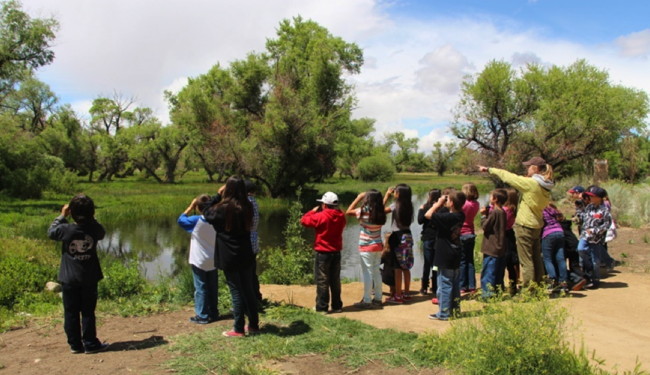
So, if you haven’t already, come check out the COSA! You can enter behind the Paiute-Shoshone Cultural Center or behind the Forest Service/BLM Building. Bring your kids or grandkids and your binoculars and wander around mowed paths under the willows. Visitors from the public are welcomed during daylight hours. And you could pick up trash and pull some weeds while you’re at it! Come on one of Audubon's monthly walks for a good introduction - see field trips, above, for more information.
Hillary Behr,
AmeriCorps Member and Wetland Restoration Coordinator,
Bishop Paiute Tribe Environmental Management Office
Back to Top
Report: Owens Lake Spring Big Day, April 23, 2014
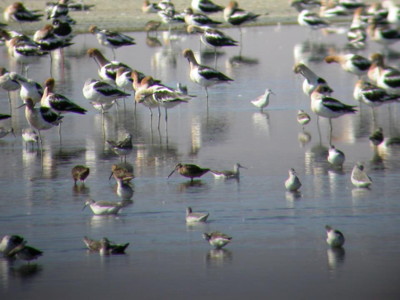
Birds on Owens Lake, Photo by Michael Prather
On April 23rd, a dozen or so volunteer birders and nine LADWP staff conducted this year’s Spring Big Day at Owens Lake. This census is one of six done each year – four by LADWP and two jointly by Eastern Sierra Audubon and DWP. Bird numbers and species' identities will help guide the enhancement and preservation of much of the enormous habitat at Owens Lake. Thanks to water being used for hazardous dust control, a food web of algae and brine flies has been re-created that sets the table for thousands of nesting and migrating birds.
Although the numbers from the day have not yet been tallied, surveyors saw good numbers of American Avocets, Least & Western Sandpipers, Wilson’s & Red-necked Phalaropes, Greater Yellowlegs, various duck species, Prairie Falcon and many Eared Grebes. The wind was cooperative and skies were blue making it a great day to be out.
When the results come in we will post them for all to see. To see the count data for the last 6 years, from 2008-2013, click here (pdf).
Owens Lake certainly has national, if not hemispheric, importance once again as a wildlife stopover. It is Inyo County's largest wildlife location and has tremendous potential for attracting wildlife viewers in fall and spring each year. Good for all of Inyo County, but especially the southern Owens Valley.
Michael Prather
Back to Top
Get Ready for Owens Lake Fall Big Day!
The Owens Lake Fall Big Day will be coming up in mid to late August - watch for your email newsletters and also check back on the website for updates.
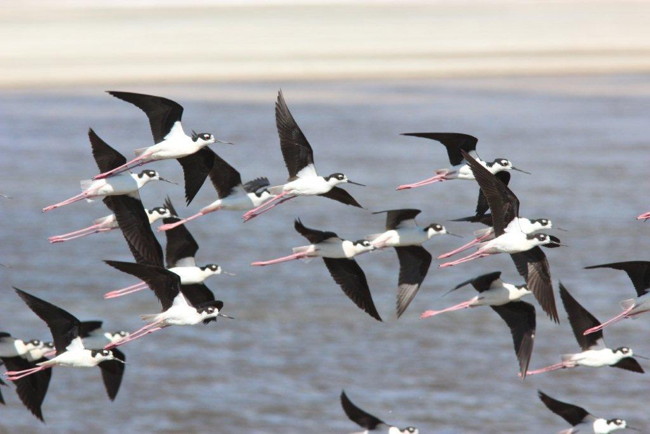
Black-necked Stilts at Owens Lake, Photo by Debby Parker
Back to Top
Taking Care of Business
Welcome New and Rejoining Members!
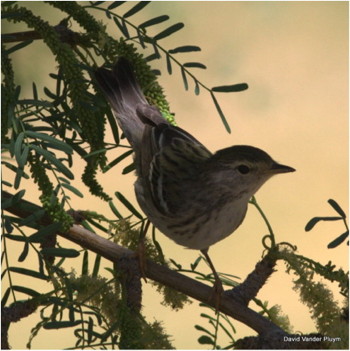
Blackpoll Warbler, photo by David Vander Pluym
Thank you to the members who joined or renewed their membership!
We'd like to take a moment to promote Chapter Memberships: You may not be aware of this, but 100% of Chapter Membership dollars stays locally in the Eastern Sierra, supporting local education, youth, conservation, and programs. If you don't need Audubon Magazine, consider joining or renewing as a Chapter-only member, or better yet, as both Chapter and National! We do get support from National Audubon, as well, so any membership helps, and is money well-spent toward bird and wildlife conservation and education, and we thank you!
Your membership donations help keep this chapter alive. We get 8-10 renewing members a month, and from 3-5 new members. Your membership dues make it possible for us to offer and support great educational and recreational events throughout the eastern Sierra. Thank you!
If you would like to join and help support Eastern Sierra Audubon, there are two ways you can do it:
- Join as a National Audubon Society Member, designating ESAS as your chapter affiliation. Includes Audubon Magazine subscription. This is $20 for the first year, and goes up to $35 annually thereafter.
- Join as an ESAS Chapter-only Member for $20 per year. 100% of your donation stays here in the Eastern Sierra this way. Your chapter membership is a way to give back, and show your appreciation for all that ESAS does, and to help support our mission locally. Your membership helps pay for scholarships, programs, special events, education programs, research, and more. THANK YOU for your support!
Click Here for a membership form to join or renew!
Join National Audubon - your zip code will associate you with the chapter nearest you.
Back to Top
How You Can Help ESAS: Four R’s (and a V)
Renew your membership (or join): The money from your membership dues is what helps us bring great evening programs, special events, - educational programs, trips, this website, and more to the community - we need your support!
Recycle at Manor Market and tell them to donate the money to Eastern Sierra Audubon.
Respect property and get permission to bird on private or restricted access property.
Repeat: Spread the word about programs and events, encourage others to join and participate.
Volunteer: Come to a board meeting and consider volunteering for an open board position! We welcome new board members, and we also always need volunteers for Birds in the Classroom, participants in bird counts, Bird-A-Thons, etc.
Message from the Editor
Our next newsletter deadline will be August 15th for the
September-October issue (there is no July-August issue, but we do send out monthly email news updates, so if you have anything you'd like to announce, you may send it in by the first of each month and we'll make sure to share it.), and of course you are always welcome to send submissions for future newsletters
and also the monthly email at any time.
We send out about one email each month to remind you of upcoming events - if you are not
on our email list, please
add yourself so you don’t miss anything!
If you send items to the newsletter
editor by the last week of any month, we’ll make sure they get included in
the next issue.
All of our content is supplied by our awesome members... if you have any ideas about articles you’d like to see, or better yet, if you have anything to share for newsletter publication, whether an article, a news item, update, correction, poem, essay, artwork, photo, field trip report, neat birding experience, letter, etc, please send it, along with any comments or suggestions, to the newsletter
editor. We’d love to hear from you!
You may send items for inclusion in the newsletter at any time, but please
send any timely items to arrive before the first of the month, so they can
be included in the monthly email update.
Thanks for reading, and happy birding!
Maggie Wolfe Riley, Newsletter Editor
Back to Top
Calendar for May-August
- Field Trip: COSA Bird Walk and Census, Saturday, May 10th
- Field Trip: Mammoth Creek, Saturday, May 17th
- Mono Lake Volunteer Training, May 28-29 and June 4, 5, 11, and 12
- Field Trip: COSA Bird Walk and Census, Saturday, June 14th
- Mono Basin Bird Chautauqua 2013: June June 20th-22nd
- Program: Birds of Brazil, July - Date and Venue TBA
- Deadline for September-October Newsletter Submissions: August 15th
- Owens Lake Fall Big Day, August TBA: watch for announcement in August (usually 3rd week in August on a Tuesday or Wednesday)
Back to Top
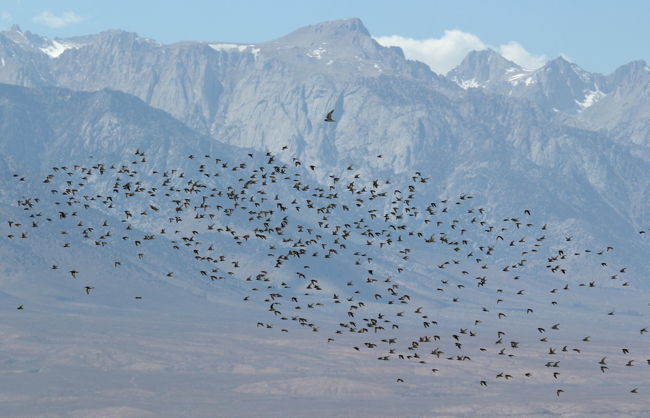
This beautiful image of a huge flock of shorebirds against the backdrop of the Sierra was taken by Kerry Wilcox and featured in California Audubon's article about the 2013 Owens Lake Spring Big Day:
120,000 Birds on the Table at Owens Lake
Back to Top
















